Bamboo is one of the oldest eco-friendly materials widely used for fencing. As a plant, bamboos are one the fastest- growing varieties and one of the largest members of the grass family. The compressive strength of Bamboo is higher than wood, brick, or concrete and even it offers a tensile strength that rivals steel.
The demand for timber is growing rapidly worldwide although the supply of timber is getting more and more restricted now. Due to its resilience and woody characteristics, Bamboo is widely used in place of wood and other materials commonly deployed in construction and related works. Bamboo has several unique advantages like the ability to grow fast with a high yield as it matures fast. Additionally, it can be produced abundantly at a lower cost that makes it more economical. It is durable i.e. it lasts long.
According to ‘Mark Johanson’[351] (Editor of Book: Black & Decker: The Complete Outdoor Builder), Bamboo is a grass, but it shares many properties similar to wood. It can be shaped, drilled, and can be improvised to an almost woody finishes, as well as it is possible to include stains and exterior sealers in bamboo structures. Besides, just like wood, bamboo is prone to splitting although it retains much of its strength even when subject to large splits and cracks. In general, larger-diameter poles of bamboo (Which can be above 5 inches – 12.5 inch) are more likely to split than smaller cans.
Bamboo is a renewable and versatile material with low weight and higher strength in its category. That’s why it is widely used in different construction forms, particularly for housing in rural areas. It is also used for producing mats, baskets, tools, handles, hats, traditional toys, musical instruments, furniture, etc. Besides, it is used for the components of house, including posts, roofs, walls, beams, floors, trusses, and fences.
One of the many uses of bamboo is to make a sturdy and well defined property fence. Here in this article, Gharpedia is going to discuss about the nitty-gritty of bamboo fencing.
What is Bamboo Fencing or Bamboo Screening?
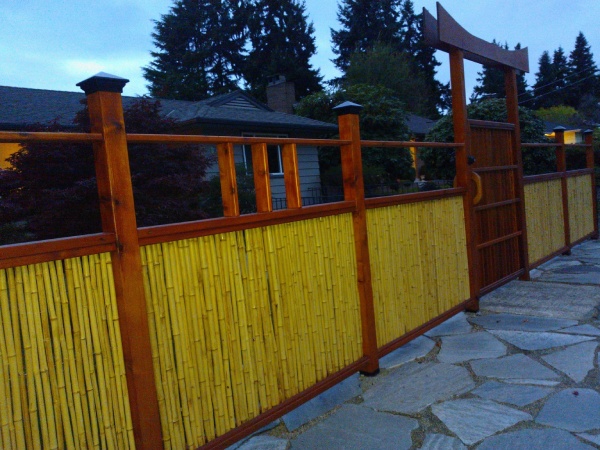
A fence is a structure used to define the boundary of a property/premise using posts, rails, wires, and barrier panels. Bamboo fencing, as implied by the name, is the type of fence made with bamboo. It is also known as bamboo screening.
Bamboo fencing is commonly available in eight-foot long panels made from similarly sized canes held together with a wire or good quality hemp cords. The panels which are rolled up for easy transport can be used as infill within a new wood framework. Also, they can be attached directly to an existing wood or metal fence.
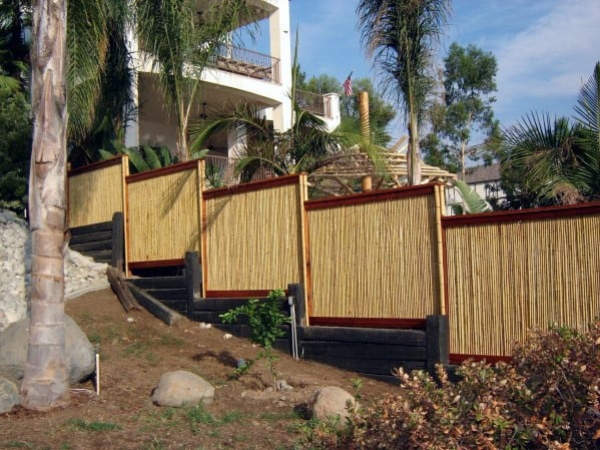
Let us see the advantages and disadvantages of bamboo fencing.
Advantages of Bamboo Fencing
01. Bamboo Fencing is Environment-Friendly
The essential quality of bamboo is its environment-friendliness. It is renewable, and bamboo forests can be grown in a quick turnaround time. It has a waxy surface that does not require painting. Pesticides and other chemicals need not to be used while cultivating bamboo, and that makes it more eco-friendly.
02. Bamboo Fences Enhance Privacy
The proper design of Bamboo screening ensures beauty of your house. It also provides both safety and privacy while enhancing your home’s elegant and green character when viewed from the street or inside the yard.
03. Bamboo Screening is an Affordable Alternative
Bamboo fencing costs lesser than other fencing i.e., wood fencing, brick wall, etc. Besides, bamboo fences are easy to install, which is pocket-friendly and gives you the option to install it yourself at a lesser cost.
04. Bamboo Privacy Fence can be easily and quickly install
Bamboo fences are easy to install, versatile, and simple to maintain. You only need to perform specific periodical maintenance to retain their appearance and durability.
Disadvantages of Bamboo Fencing
01. Bamboo Privacy Fence has lesser life span
Bamboo is often attacked by fungi and insects. For this reason, untreated bamboo is viewed as a temporary fencing option with an expected life of less than five years.
02. Bamboo Fences cannot Resist Fire
Bamboo catches fire very quickly, and cost of treatment is relatively high.
03. Bamboo Fences cannot be Nailed
In almost all cases, bamboo cannot be nailed. Most joints in fencing are made with wire or hemp cords.
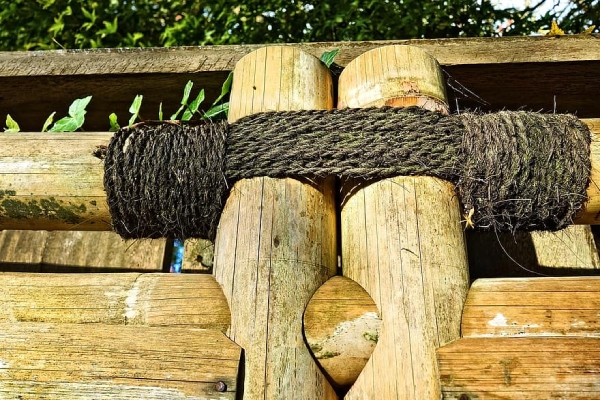
After knowing the advantages and disadvantages of the bamboo fence, let us look at its installation process.
Bamboo Fencing Installation
Before installing a bamboo fence, it is necessary to choose the type of bamboo, so that the fence is made the best suitable for your home’s boundary. Also, don’t forget to consider the area where you will be putting your bamboo fencing and also plan beforehand how it will be installed. Will it make a difference if you install it in the close vicinity of the house? Will it be under the bright shade, or it will be placed in a humid area, or the fencing will be built in a dry and hard-soiled area.
Here we are going to discuss some options for installing a bamboo fence. You can choose the right option for your house boundary from the following options:
01. Bamboo Fence Construction with Wood Frame
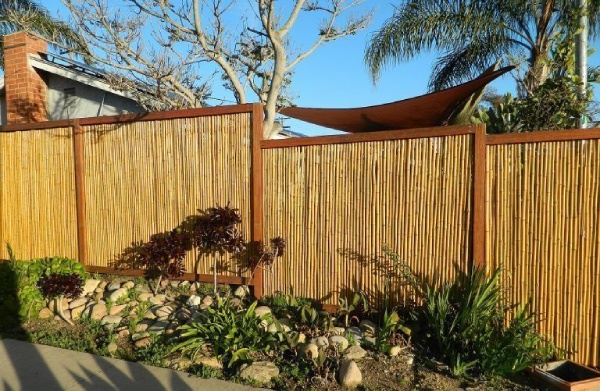
02. Bamboo Fence Installation on Existing Wooden Fence
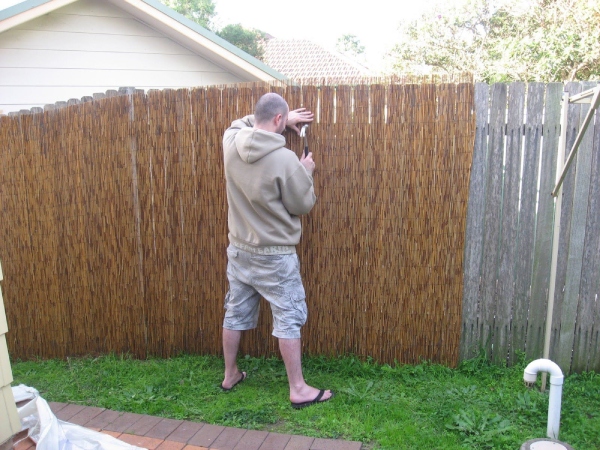
03. Bamboo Screening Installation on Block or Brick Wall

04. Bamboo Fence Installation on Existing Chain Link Fence
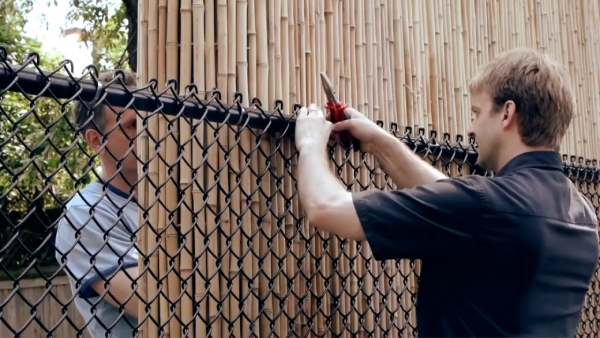
How to Build Bamboo Fence with Wood Frame?
Bamboo fences can be easily built, and you can make them all by yourself. You need to follow the following simple steps to complete your DIY project:
01. Fence installation begins with plotting the fence line and marking the post location.
02. Dig holes in 6 feet apart distance, and each hole will be at least 2 feet deep.
03. Install and trim the 4 feet X 4 feet posts according to your bamboo panels’ size into holes and fill the holes with concrete.
04. Install horizontal rails near the top and bottom of the posts. Make sure that the horizontal rails are leveled with the back of the 4 foot X 4 foot post.
05. Flatten the bamboo panels over the inside faces of the horizontal rails. Make sure that the panels fit the frame on all sides.
06. Predrill the bamboo poles with a drill: make the hole slightly smaller than the diameter of the deck screw. Fasten bamboo roll onto the horizontal rail with a deck screw being ultra-careful so that you don’t make the mistake of tightening and splitting the bamboo.
07. Fasten the rest of the bamboo panel with screw spaced 1 foot apart. Stagger the screw top and bottom and drive them in an alternating pattern, and start working from one side to another.
08. Cover the top and bottom-ends of the bamboo panel with 1 foot X 4 foot battens. These battens will finalize the panels and give the fence a similar look on both the sides.
09. Cut the battens, so the ends seen flat against the posts’ inside faces, and fasten them to the panels and horizontal rails with a deck screw.
How to cover an Existing Fence with Bamboo?
Bamboo fences can be installed over existing fences. The following points are the simple steps for installation:
01. Unroll and position a bamboo panel over one or both the sides of a bamboo fence. Check the bamboo panel with a level and adjust as needed. For rot prevention, hold the bamboo panel 2 to 13 inches above the ground.
02. Fasten the panel with deck screws driven through the bamboo canes and stay fixed into the existing fence rail.
03. Drill holes for the screws, being careful not to over tighten and crack the bamboo. Space the screw 1 foot apart and stagger them top and bottom. Fasten the rest bamboo panel with screw and drive them in an alternating pattern.
04. If you are installing a bamboo fence over existing chain links fences, prefer using galvanized steel wire instead of screws.
05. Cover the top and bottom ends of the bamboo panel with battens. These battens add a finished look of the panels and give the fence a similar look on both the sides.For more in detail about bamboo fence installation, watch this online documentary by “Bamboo Fencer”
By now we have gone through the details regarding the basic information about installing a bamboo fence for marking the boundary of your home. Now when you have chosen the bamboo fence according to your need, let’s understand how to take care of your bamboo fence for better and extended service life.
Bamboo Fencing Care and Maintenance
Like any other type of fence, a bamboo fence needs regular maintenance. Check in every few months’ interval if your bamboo fence is broken or somehow damaged. The nests of the insect is another potential problem for the maintenance of bamboos. Call the insect destroyer if you see the signs of termite infestation.
If any rough edge or pieces of the bamboo exists on the fence, it needs to be removed, especially if you have pets or children that are likely to play around the fencing. You also may need to check in the problem niches that need to be treated with herbicide, pesticide or fungicide to make your fence damage-proof.
Is Painting Necessary for the Maintenance of a Bamboo Fence?
You can apply paints and varnishes to the bamboo surface to protect it from dirt and moisture and it will create some decorative effects. They form a layer on the surface of the bamboo. Blistering of the paint or varnish leaves the bamboo surface exposed, and it can lead to fungal and insect attacks. Therefore, it is recommended to provide a protective coating of preservative before smearing paints and varnishes on the bamboo fence.
Does Bamboo Fences Need any Foundation?
Bamboo fences do not require a foundation ideally, and you can easily install it in the ground. But there are certain limitations to installing it directly into the ground. Bamboo is an above-ground material. Unless it is treated with a preservative, it may last only for 2-3 years underground. Therefore, it is advisable to install a bamboo fence on an existing brick wall, block wall, or chain link fence: it will prolong its service life.
Summing up, Bamboo is a substitute building material, which is 100%renewable, a green option, environment friendly, and widely available. Bamboo presently has emerged as a suitable alternative to timber due to its rapid growth, adaptability to most of the climatic conditions, low maintenance benefits, and its similarity to wood properties.
Bamboo offers a unique decorative quality that can be used to create an attractive fence. Bamboo fencing is available in a variety of shapes, heights, rolls, and panels. Besides, you can make it yourself and you will get to enjoy your beautiful, eco-friendly bamboo fence at an affordable price!
Before you leave this page, read interesting blogs on different types of fencing, here –

